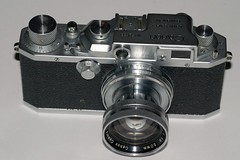Difference between revisions of "Canon II/III/IV"
m (correcting Collection Appareils link) |
m (Caption edit) |
||
| (9 intermediate revisions by 5 users not shown) | |||
| Line 1: | Line 1: | ||
{{Japanese 35mm focal plane VF and RF | {{Japanese 35mm focal plane VF and RF | ||
| − | |image=[http://www.flickr.com/photos/ | + | |image=[http://www.flickr.com/photos/90900361@N08/8328688122/in/pool-camerawiki/ http://farm9.staticflickr.com/8351/8328688122_b354cb954b_n.jpg]<br>Canon IVSB with Serenar f/1.8 lens<br><small>Image by {{image author|Geoff Harrisson}} {{with permission}}</small> |
}} | }} | ||
| + | |||
The [[Canon]] [[rangefinder camera|rangefinders]] of the late 1940s and early 1950s are [[Leica]]-compatible [[leica thread mount|screw-mount cameras]]. Many were brought to the U.S. by servicemen who bought them while visiting Japan during the Korean war. Typically they were mounted with a 50mm [[Canon 39mm screw lenses|Serenar (later, Canon) lens]]. | The [[Canon]] [[rangefinder camera|rangefinders]] of the late 1940s and early 1950s are [[Leica]]-compatible [[leica thread mount|screw-mount cameras]]. Many were brought to the U.S. by servicemen who bought them while visiting Japan during the Korean war. Typically they were mounted with a 50mm [[Canon 39mm screw lenses|Serenar (later, Canon) lens]]. | ||
| Line 11: | Line 12: | ||
Where the Canon cameras surpass the Leica is the finder. Viewfinder and rangefinder are integrated, and a three-way switch allows a view for 50mm, 100mm, and critical [[rangefinder (device)|rangefinder ]]use. | Where the Canon cameras surpass the Leica is the finder. Viewfinder and rangefinder are integrated, and a three-way switch allows a view for 50mm, 100mm, and critical [[rangefinder (device)|rangefinder ]]use. | ||
| − | {{ | + | {{Flickr image |
| − | |image_source= http://www.flickr.com/photos/ | + | | image_source=http://www.flickr.com/photos/rst90274/2568299990/in/pool-camerawiki/ |
| − | |image= http://static.flickr.com/ | + | | image=http://farm3.static.flickr.com/2143/2568299990_5b6dac37af_m.jpg |
| − | |image_align= | + | | image_align= |
| − | |image_text= Canon | + | | image_text=Canon II-S |
| − | |image_by= | + | |image_by= rst12 |
| − | |image_rights= | + | |image_rights= with permission |
}} | }} | ||
| − | |||
| − | |||
| − | |||
| − | |||
| − | |||
| − | |||
{{Flickr image | {{Flickr image | ||
| image_source=http://www.flickr.com/photos/rst90274/2812060730/in/pool-camerawiki/ | | image_source=http://www.flickr.com/photos/rst90274/2812060730/in/pool-camerawiki/ | ||
| image=http://farm4.static.flickr.com/3139/2812060730_3594060ef2_m.jpg | | image=http://farm4.static.flickr.com/3139/2812060730_3594060ef2_m.jpg | ||
| − | | image_align= | + | | image_align= |
| image_text=Canon III | | image_text=Canon III | ||
|image_by= rst12 | |image_by= rst12 | ||
|image_rights= with permission | |image_rights= with permission | ||
}} | }} | ||
| − | *[http://www. | + | == Further reading == |
| + | In Japanese: | ||
| + | *Ōba Eiichi (大場栄一). ''Kyanon no tsukaikata'' (キヤノンの使い方, How to use the Canon). Tokyo: Kōgasō, 1955.<!-- not seen --> | ||
| + | |||
| + | == Links== | ||
| + | * [http://www.butkus.org/chinon/canon/canon_ii_d_iv_s2/canon_ii_d_iv_s2.htm Canon II/D/IV/S User Manual] at [http://www.butkus.org/chinon/index.html butkus.org] | ||
| + | In French : | ||
| + | *Canon Rangefinders at [http://www.collection-appareils.fr/general/html/francais.php www.collection-appareils.com] by Sylvain Halgand : | ||
**[http://www.collection-appareils.fr/x/html/page_standard.php?id_appareil=10523 Canon II B] | **[http://www.collection-appareils.fr/x/html/page_standard.php?id_appareil=10523 Canon II B] | ||
| − | |||
| − | |||
| − | |||
**[http://www.collection-appareils.fr/x/html/page_standard.php?id_appareil=10524 Canon III] | **[http://www.collection-appareils.fr/x/html/page_standard.php?id_appareil=10524 Canon III] | ||
| − | **[http://www.collection-appareils.fr/x/html/page_standard.php?id_appareil= | + | **[http://www.collection-appareils.fr/x/html/page_standard.php?id_appareil=10526 Canon IV F] |
| − | + | ||
| − | + | ||
| − | |||
| − | |||
| − | |||
| − | |||
| − | |||
| − | |||
| − | |||
| − | |||
| − | |||
| − | |||
[[Category: 39mm screw mount]] | [[Category: 39mm screw mount]] | ||
[[Category: Japanese 35mm rangefinder]] | [[Category: Japanese 35mm rangefinder]] | ||
| − | [[Category: Canon]] | + | [[Category: Canon|2]] |
[[Category: C]] | [[Category: C]] | ||
Revision as of 07:56, 8 February 2019
The Canon rangefinders of the late 1940s and early 1950s are Leica-compatible screw-mount cameras. Many were brought to the U.S. by servicemen who bought them while visiting Japan during the Korean war. Typically they were mounted with a 50mm Serenar (later, Canon) lens.
Many of them are still in use, and are similar in function to the Leica IIIg. There is a top speed of 1/500 or 1/1000, and on some models, flash synchronization (via a proprietary connection), and the Leica-mount flange replaced the similar but incompatible "Canon mount" of earlier Canon rangefinders. These new cameras can use any Leica-mount lens.
The original ones came with a spring-loaded takeup spool that most photographers found easier to use than the one provided by Leica -- many are now missing the spool since the spools were taken for use in Leica cameras.
Unlike many Leica copies, quality control and finish are fully up to Leitz standards.
Where the Canon cameras surpass the Leica is the finder. Viewfinder and rangefinder are integrated, and a three-way switch allows a view for 50mm, 100mm, and critical rangefinder use.

|
| Canon II-S image by rst12 (Image rights) |

|
| Canon III image by rst12 (Image rights) |
Further reading
In Japanese:
- Ōba Eiichi (大場栄一). Kyanon no tsukaikata (キヤノンの使い方, How to use the Canon). Tokyo: Kōgasō, 1955.
Links
In French :
- Canon Rangefinders at www.collection-appareils.com by Sylvain Halgand :
